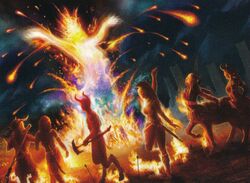Great Revel
| Great Revel | |||||
|---|---|---|---|---|---|
| Xenagos's Revel | |||||
| Information | |||||
| Era | Mending Era | ||||
| Date | 4559 AR | ||||
| Location | Akros, Theros | ||||
| Sets | Born of the Gods | ||||
| Characters | Anax, Cymede, Daxos, Elspeth, Iroas, Keranos, Mogis, Nikka Takis, Rhordon, Sarpedon, Xenagos | ||||
| Result | |||||
| Timeline | |||||
| |||||
The Great Revel, also known as Xenagos’s Revel, was a pivotal event in Theros's history, marking the moment when the satyr planeswalker Xenagos ascended to godhood. Occurring in 4559 AR during the Mending Era, the Great Revel transformed a hard-won victory celebration in Akros into a catastrophe that shook both the mortal and divine realms.[1]
Description
During the Silence of the Gods — a period when the divine withdrew from mortal supplication — Xenagos, a cunning satyr, uncovered the truth that a god’s power waxed and waned with mortal belief. Determined to upend the pantheon, Xenagos orchestrated a grand deception during a desperate siege on Akros by the minotaur horde of Mogis — a siege he had secretly engineered.
Elspeth Tirel, the Sun’s Champion, arrived in Akros with the soldier-oracle Daxos after a dire vision from the sphinx Medomai. They found the city encircled by Mogis’s minotaurs and a massive barricade cutting off reinforcements. King Anax, Queen Cymede, and Elspeth confronted Xenagos — imprisoned yet smiling — who offered a plan to break the siege by flooding the enemy encampment with the Deyda River.
The plan demanded a bold diversion: King Anax challenged Rhordon the Rageblood, a brutal oracle of Mogis, to single combat, with Elspeth as his second. Meanwhile, Cymede and Daxos called on Keranos’s storm-might to unleash the river as a raging elemental. Despite divine meddling — Mogis empowering Rhordon and Keranos grudgingly answering Cymede’s plea — the plan succeeded. Rhordon and his minotaur horde were swept away, but Anax was left grievously wounded.
Victorious yet exhausted, Akros declared a festival to honor its salvation. In a quiet moment, Elspeth and Daxos at last confessed their love. But Xenagos’s plot reached its climax: appearing within their tent with the Erebos-bound Sarpedon, he forced Elspeth to relive her darkest trauma — her clash with a Phyrexian Obliterator. Panicked, she struck down Daxos, realizing too late he was no monster. Sarpedon, too, was killed, while Xenagos vanished into the riotous night.
Outside, the party spiraled into a frenzied, otherworldly revel. Xenagos fed on the mortal fervor to breach Nyx, the divine realm. The mortals’ wild belief crowned him the new God of Revels amid chaos, carnage, and ecstatic dance. Elspeth, reeling, fled with Nikka Takis, who had safeguarded her sword, denying Xenagos one of his trophies. Together they climbed to Heliod's shrine as Akros writhed below, the Great Revel blazing like a living serpent of fire through the streets.
At dawn, Xenagos rose shimmering into the starry Nyx, leaving his mortal life behind. Branded a traitor for Daxos’s death and blamed for the new usurper god, Elspeth vanished into the wilderness, hunted by those she had saved. Anax survived but was forever marked by the revel that turned his people’s faith into a weapon against the divine.
The Great Revel set in motion Heliod’s bitter crusade against Xenagos — the “usurper” — and foreshadowed Elspeth’s tragic fate at her patron’s hand. It stands as a stark reminder that on Theros, even gods are born — and undone — by mortal will.[1]
References
- ↑ a b Jenna Helland (May 2014) – Journey into Nyx: Godsend, Part II, Wizards of the Coast.
